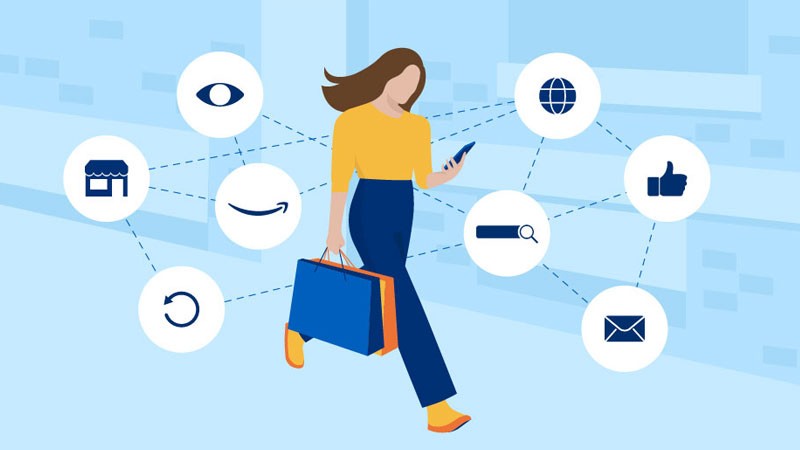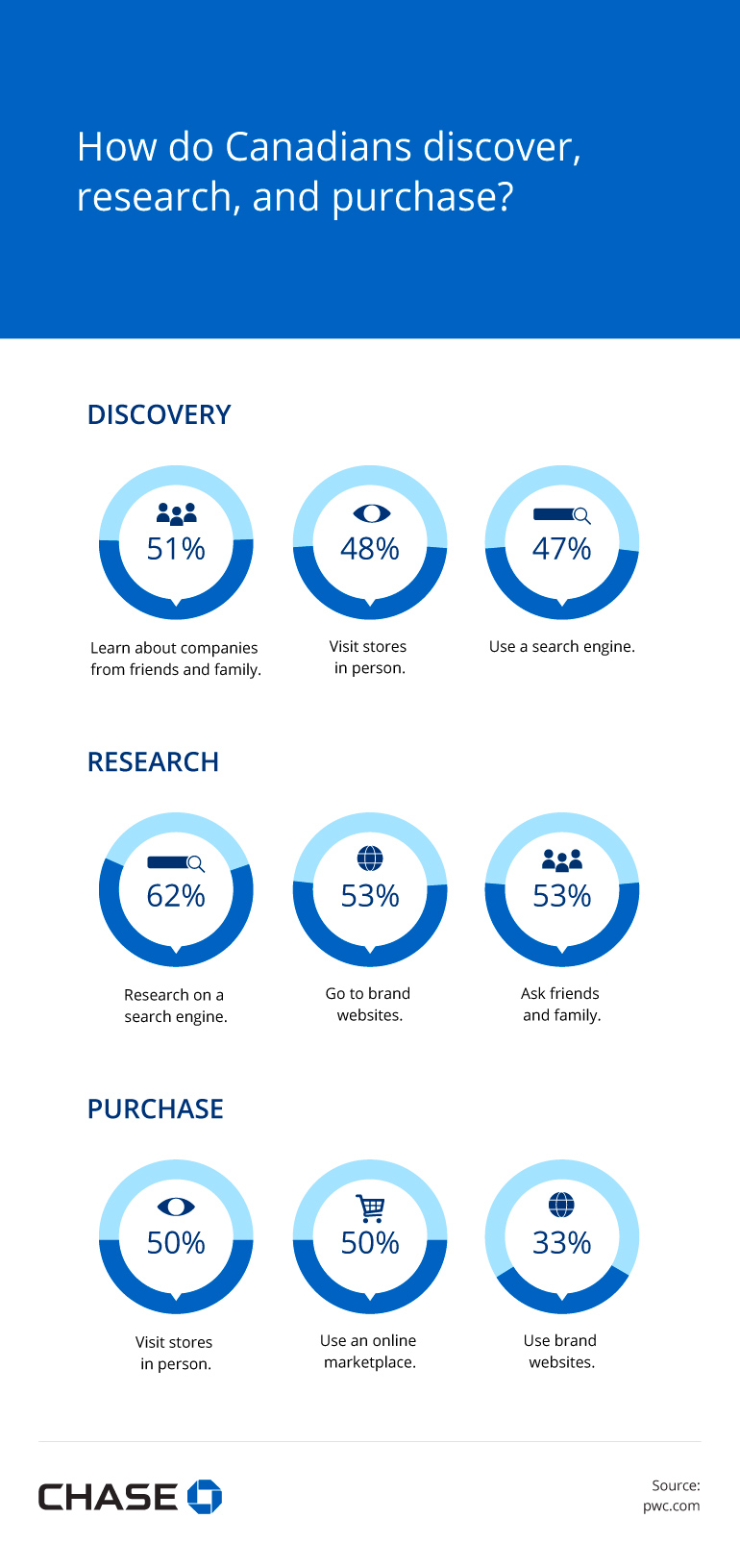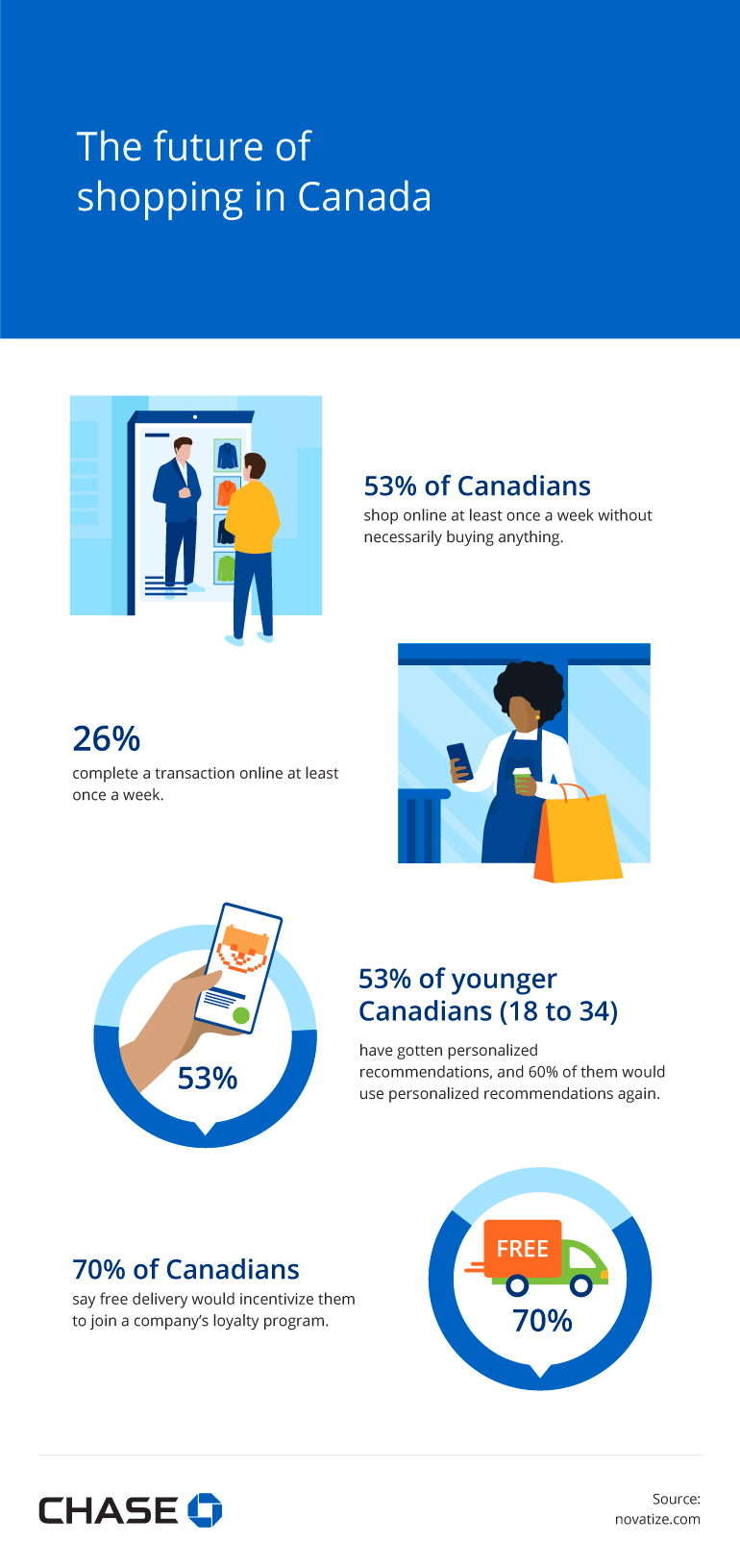How to create an omnichannel strategy for retailers
By Jessica Bennett

Our world is more interconnected than ever and so are your customers. They want personalized interactions with your business no matter where they find you. They also want a consistent and interconnected experience.
This type of cohesive customer journey isn’t just a “nice to have.” More and more, customers expect it, especially younger buyers. Today’s companies don’t just need to be everywhere. They must also integrate their marketing channels to provide a united message and experience. The future of retail is omnichannel marketing. Read on to understand the benefits of omnichannel marketing.

Discovery:
- 51% learn about companies from friends and family.
- 48% visit stores in person.
- 47% use a search engine.
Research:
- 62% research on a search engine.
- 53% go to brand websites.
- 53% ask friends and family.
Purchase:
- 50% visit stores in person
- 50% use an online marketplace.
- 33% use brand websites.
Source:
What is omnichannel marketing?
The foundation of an omnichannel marketing approach is to provide customers with a consistent message and experience across all marketing channels. The customer’s journey is at the heart of the process.
How does omnichannel retail marketing unfold in the real world? It means customers should be able to easily interact with your company on all their devices, including smartphones, laptops, desktops, and smartwatches — as well as in your physical store.
Consistency across channels is especially important. Most Canadians (79%) shop online, according to Statistics Canada, but 67% in a PwC Canada study prefer to shop in brick-and-mortar stores. Clearly, many Canadians are comfortable mixing and matching their shopping channels.
The keys to omnichannel marketing include:
- Unified branding across marketing channels and touchpoints. Marketers must strive for a consistent look, feel, and tone on every platform a customer visits.
- Seamless transactions with flexible payment options across all platforms. Customers should be able to research, buy, pick up, and return items across channels. For instance, they may research on a website, buy on an app, and pick up in-store.
- Personalized experiences. Customers also want a personalized and curated experience across channels. These experiences could include receiving personalized push notifications announcing favoured items are on sale or talking to an in-store sales rep who makes recommendations based on a customer’s past online and in-app purchases.

- Unified branding
Strive for a consistent look, feel, and tone across platforms - Seamless transaction
Allow customers to research, buy, pick up, and return items across channels. - Personalized experiences
Create tailored recommendations for your customers online and in-store.
Omnichannel marketing vs. multichannel marketing
Most businesses today focus on a multichannel marketing strategy, which seeks to have a presence across multiple touchpoints. For example, a business might have a website, a Facebook page, and an Instagram page in addition to a physical store location. While they manage multiple marketing channels, this business does not have an omnichannel strategy.
The missing piece is integration across the channels that creates a seamless experience for the customer. A company’s social media department may showcase a product on its Instagram page. Is that product available on the company’s website, in their store, and on their app? Can a customer receive personalized recommendations for the product’s accessories that match their needs? Can the customer also choose the size and colour product they want online and pick it up at their local store? That’s the difference between multichannel marketing and omnichannel marketing.
In today’s hyper-competitive environment, businesses need to break down the walls between siloed marketing channels to create a fully connected marketing strategy ecosystem.
How to implement an omnichannel marketing strategy
Ready to connect all the pieces of your company’s marketing efforts into a cohesive omnichannel strategy? Be warned that implementing an omnichannel strategy requires significant planning, buy-in across company departments, and an overhaul of your current marketing efforts (including how to take payments across different channels).
Here’s how to get started.
Integrate your teams
Consistency and cohesion are the name of the game when it comes to creating an omnichannel experience. Multiple teams and departments need to work in sync toward the same goal.
It’s time to integrate every team that plays a role in a customer’s buying journey, which may include your:
- Marketing team
- Social media team
- Web team
- Sales team
- Analytics team
- IT department
- Development team
- Product management team
Integration may be the most difficult part of the omnichannel equation, which is why buy-in at every level, especially in the C-suite, is crucial to the success of an omnichannel strategy.
Review your customer journey
A customer journey consists of the actions a person takes when they do business with you. The five stages include awareness, consideration, purchase, retention, and advocacy. Creating an omnichannel marketing strategy begins by understanding every step of your customer’s journey.
Use your existing analytics to map out these journeys. Which channels do your customers use? What are the weak points of these channels? How can you integrate these channels?
Now may also be a good time to review and update your company’s buyer personas. A buyer persona is a detailed description of a single person who represents your target audience.
Identify your channel breakdown
Now comes the fun part. Once you’ve brought all your teams on board and defined your customer journey, it’s time to figure out how to create a unified experience across all your channels.
For a customer, a unified retail experience may mean a customer gets a personalized product recommendation via email. They use the store’s app to virtually test the product from home and place and pay for the order. They choose the option of picking the product up in-store for free. There, they browse for additional items and the assisting sales rep can see their online buying history and app activity to make personalized recommendations.
Don’t let this step overwhelm you. Start small with just a few of your primary channels and iterate from there. For example, can you pull analytics from your website to create personalized email and in-app notifications to customers?
Can you add in-store pickups for online purchases? What about equipping sales reps with tablets that let them pull up a customer’s buying history when that customer asks for help?
Focus on a few primary channels at a time and remember that an omnichannel strategy is always a work in progress.
Ensure an easy checkout experience
No matter where your customer is — your website, in-store, or on social — it’s important to establish a smooth checkout experience. When the checkout process is confusing, drawn out, or complicated, customers are more likely to abandon online shopping carts.
The Baymard Institute, an independent web UX research firm, conducted a data analysis of 49 different studies and estimated a cart abandonment rate of 70.19%. Many customers simply use their carts for browsing and aren’t ready to make a purchase. But the Baymard Institute pinpointed other reasons for cart abandonment:
- 19% of customers left because the site wanted them to create an account.
- 18% said the checkout process was too long or complicated.
- 15% said the website had errors or crashed.
- 14% said they couldn’t see or calculate the total order cost.
- 10% said the merchant didn’t offer enough payment methods.
Analyze your checkout process to see if you have any of the above issues, and consider how you can optimize the checkout process across channels.
Create Loyal Customers
Your customers already trust you. It’s easier to sell products to them, and they may spend more than new customers.
Take a close look at your post-purchase messaging. Do you send an order confirmation, support information, a feedback request, and/or a promotional offer for a related item? Make sure this messaging fits into your omnichannel strategy by taking the following steps:
- Integrate your messages across channels so customers receive the same message wherever they interact with your brand.
- Encourage cross-channel engagement. For example, in your email confirmation, you could encourage the customer to follow you on social or download your app.
- Provide a seamless experience no matter where a customer interacts. For example, if a person places an online order, make sure they can check the order status in your store or on your app.
- Personalize all messages and offers based on the channel a person interacts with most. For example, send info about store events to people who shop in your store and virtual coupons to online shoppers.
- Collect feedback through surveys, reviews, or social chats to inform your future strategies.
Assess your progress
Marketing professionals already know that in our fast-changing world, you can never really “set it and forget it.” Once your omnichannel marketing strategy is up and running, analyze your data. How are customers reacting to your new and improved customer journey? Are sales and retention picking up? What can you be doing to add even more connections between marketing channels?
Never stop iterating.
How a strong omnichannel strategy benefits retailers
Is implementing an omnichannel marketing strategy worth all the effort and disruption? The simple, straightforward answer is yes. It can offer your business the following advantages.
Better customer experience
The most obvious benefit of an omnichannel marketing strategy is that retailers can give their customers a smoother, more seamless experience. When your customers can shop and pay the way they want across any marketing channel and device, they’ll reward you with their dollars and loyalty.
Greater sales opportunities
Syncing your marketing channels gives you more opportunities to connect and sell to interested prospects. According to the Bazaarvoice's Shopper Experience Index, 88% of consumers in Canada and seven other countries surveyed want a seamless shopping experience across channels.
Increased customer loyalty
A well-executed omnichannel strategy gives customers a personalized experience that can build brand loyalty.

- 53% of Canadians shop online at least once a week without necessarily buying anything.
- 26% complete a transaction online at least once a week.
- 53% of younger Canadians (18 to 34) have gotten personalized recommendations, and 60% of them would use personalized recommendations again.
- 70% of Canadians say free delivery would incentivize them to join a company’s loyalty program.
Source:
The future of omnichannel marketing is now
Retailers can no longer afford to host fragmented marketing channels that don’t work together. Today’s youngest customers are digital natives who expect access to brands 24/7 on all their devices. McKinsey & Company puts it best when they say “…younger buyers, like Gen Zers, embrace omnichannel enthusiastically; these customers don’t think in terms of traditional channel boundaries, and they expect brands and retailers to provide a seamless experience, no matter where they are.”
The future is omnichannel. Companies that offer a seamless customer experience across channels — with flexible payment solutions in-store, online, and on the go — could be on their way to earning enthusiastic buyer loyalty and growing profits.